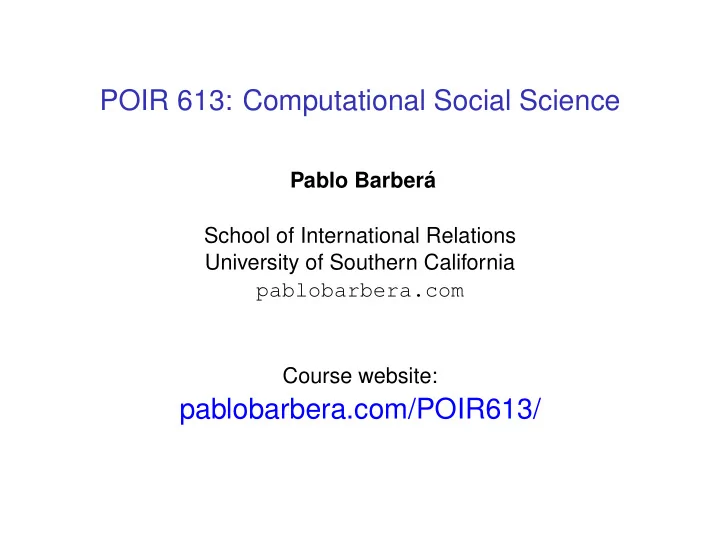

POIR 613: Computational Social Science Pablo Barber´ a School of International Relations University of Southern California pablobarbera.com Course website: pablobarbera.com/POIR613/
Today 1. Project ◮ Next milestone: 5-page summary that includes some data analysis by November 4th 2. Word embeddings ◮ Overview ◮ Applications ◮ Bias ◮ Demo 3. Event detection; ideological scaling 4. Solutions to challenge 7 5. Additional methods to compare documents
Overview of text as data methods
Word embeddings
Beyond bag-of-words Most applications of text analysis rely on a bag-of-words representation of documents ◮ Only relevant feature: frequency of features ◮ Ignores context, grammar, word order... ◮ Wrong but often irrelevant One alternative: word embeddings ◮ Represent words as real-valued vector in a multidimensional space (often 100–500 dimensions), common to all words ◮ Distance in space captures syntactic and semantic regularities, i.e. words that are close in space have similar meaning ◮ How? Vectors are learned based on context similarity ◮ Distributional hypothesis: words that appear in the same context share semantic meaning ◮ Operations with vectors are also meaningful
Word embeddings example word D 1 D 2 D 3 . . . D N man 0.46 0.67 0.05 . . . . . . woman 0.46 -0.89 -0.08 . . . . . . king 0.79 0.96 0.02 . . . . . . queen 0.80 -0.58 -0.14 . . . . . .
word2vec (Mikolov 2013) ◮ Statistical method to efficiently learn word embeddings from a corpus, developed by Google engineer ◮ Most popular, in part because pre-trained vectors are available ◮ Two models to learn word embeddings:
Word embeddings ◮ Overview ◮ Applications ◮ Bias ◮ Demo
Source: Kozlowski et al, ASR 2019
Cooperation in the international system Source: Pomeroy et al 2018
Semantic shifts Using word embeddings to visualize changes in word meaning: Source: Hamilton et al, 2016 ACL. https://nlp.stanford.edu/projects/histwords/
Application: semantic shifts Using word embeddings to visualize changes in word meaning: Source: Hamilton et al, 2016 ACL. https://nlp.stanford.edu/projects/histwords/
Dictionary expansion Using word embeddings to expand dictionaries (e.g. incivility) Source: Timm and Barber´ a, 2019
Word embeddings ◮ Overview ◮ Applications ◮ Bias ◮ Demo
Bias in word embeddings Semantic relationships in embeddings space capture stereotypes: ◮ Neutral example: man – woman ≈ king – queen ◮ Biased example: man – woman ≈ computer programmer – homemaker Source: Bolukbasi et al, 2016. arXiv:1607.06520 See also Garg et al, 2018 PNAS and Caliskan et al, 2017 Science.
Word embeddings ◮ Overview ◮ Applications ◮ Bias ◮ Demo
Event detection in textual datasets
Event detection (Beieler et al, 2016) Goal: identify who did what to whom based on newspaper or historical records. Methods: ◮ Manual annotation: higher accuracy, but more labor and time intensive ◮ Machine-based methods: 70-80% accuracy, but scalable and zero marginal costs ◮ Actor and verb dictionaries; e.g. TABARI and CAMEO. ◮ Named entity recognition, e.g Stanford’s NER Issues: ◮ False positives, duplication, geolocation ◮ Focus on nation-states ◮ Reporting biases: focus on wealthy areas, media fatigue, negativity bias ◮ Mostly English-language methods
Ideological scaling using text as data
Wordscores (Laver, Benoit, Garry, 2003, APSR) ◮ Goal: estimate positions on a latent ideological scale ◮ Data = document-term matrix W R for set of “reference” texts, each with known A rd , a policy position on dimension d . ◮ Compute F , where F rm is relative frequency of word m over the total number of words in document r . ◮ Scores for individual words: ◮ P rm = F rm r F rm → (Prob. we are reading r if we observe m ) � ◮ Wordscore S md = � r ( P rm × A rd ) ◮ Scores for “virgin” texts: ◮ S vd = � w ( F vm × S md ) → (weighted average of scored words) � � SD rd ◮ S ∗ vd = ( S vd − S vd ) + S vd → Rescaled scores. SD vd
Wordfish (Slapin and Proksch, 2008, AJPS) ◮ Goal: unsupervised scaling of ideological positions ◮ Ideology of politician i , θ i is a position in a latent scale. ◮ Word usage is drawn from a Poisson-IRT model: W im ∼ Poisson ( λ im ) λ im = exp ( α i + ψ m + β m × θ i ) ◮ where: α i is “loquaciousness” of politician i ψ m is frequency of word m β m is discrimination parameter of word m ◮ Estimation using EM algorithm. ◮ Identification: ◮ Unit variance restriction for θ i ◮ Choose a and b such that θ a > θ b
Recommend
More recommend